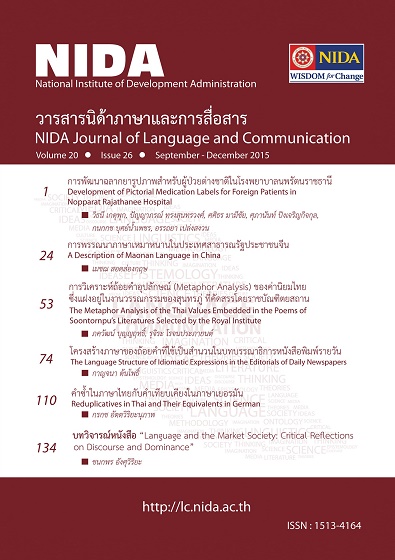THE LANGUAGE STRUCTURE OF IDIOMATIC EXPRESSIONS IN THE EDITORIALS OF DAILY NEWSPAPERS
Keywords:
Language Structure, Idiomatic Expression, Editorials of Daily NewspapersAbstract
This research aims to study the language structure of idiomatic expressions in the editorials of daily newspapers that were published and circulated from January 1, 2013 to December 31, 2013. The researcher collected the data from three newspapers: Krungthep Thurakij, Thai Rath and Matichon. The study found that there are three types of language structure of the Idiomatic expressions in the editorials, namely words, phrases and sentences. These expressions function as a unit which is equivalent to one word and it means only one thing in particular. These expressions do not have direct or word-for-word meanings, but their meanings are given by means of comparison, whose connotative meanings differ from that of the originals. The idiomatic expressions found in the newspapers consist of (a) old expressions, (b) expressions that were adapted from old expressions, (c) expressions that modify the context of usage, and (d) newly coined expressions. All these are distinctive characteristics of the use of expressions in the editorials of the daily newspapers, which arouse emotions and feelings and enable reader to vividly imagine the ideas.
Downloads
How to Cite
Issue
Section
License
By submitting a manuscript, the author transfers the copyright for the article to School of Language and Communication, National Institute of Development Administration (NIDA), if and when the manuscript is accepted for publication. Though the journal is an open-access, reproduction of any material published in NIDA Journal of Language and Communication for non-personal and/or commercial purpose requires a written permission from School of Language and Communication, National Institute of Development Administration (NIDA).






